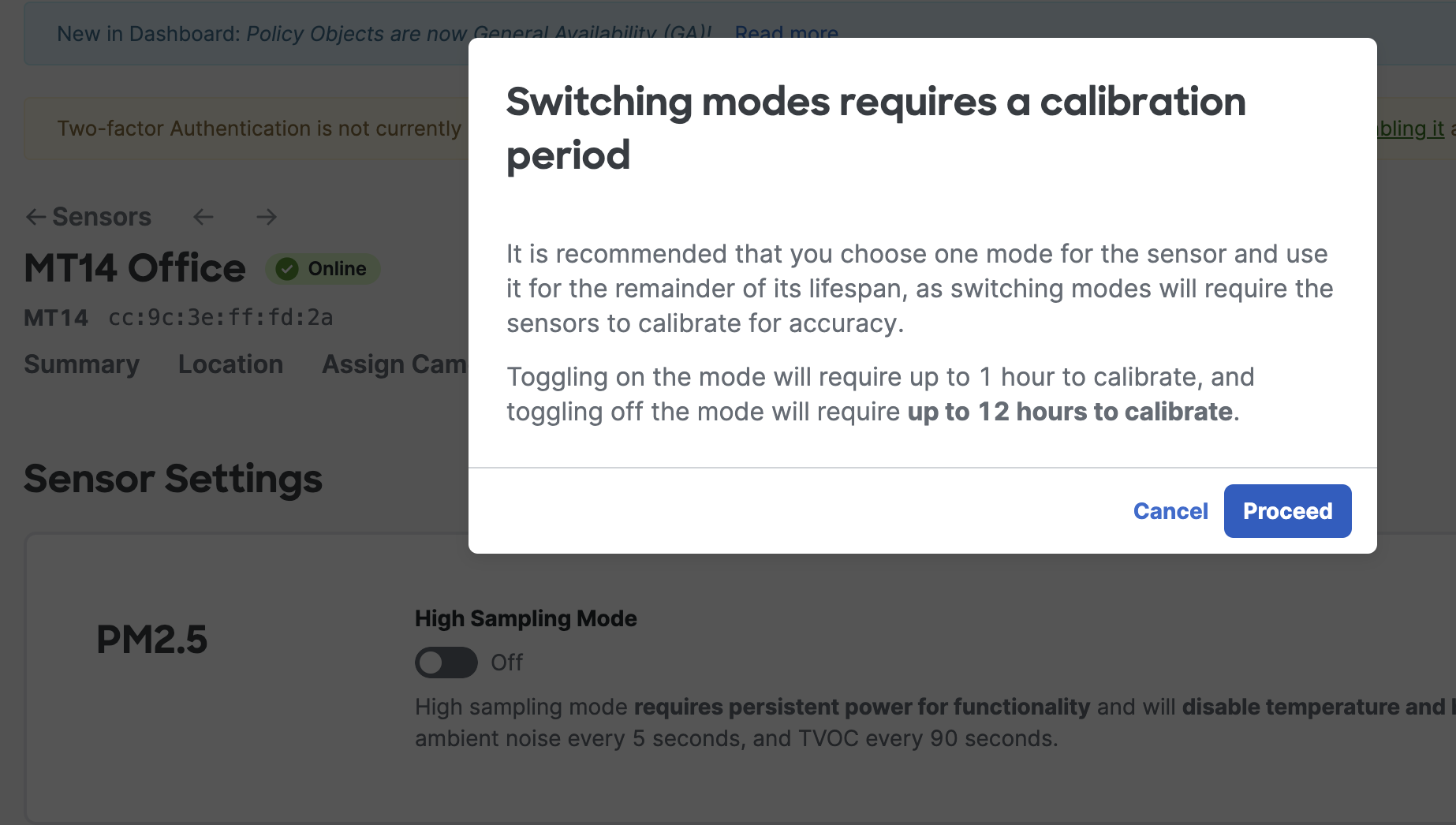MT14 High Sampling Mode
Overview
High Sampling Mode on MT14 allows the sensor to enable faster sampling rate. This can be configured for key metrics that users may be interested in collecting more frequently according to the use case.
High Sampling Mode
The High sampling mode changes the following metrics:
|
Metric |
Sampling Rate (High Sampling Mode Disabled) |
Sampling Rate (High Sampling Mode Enabled) |
|---|---|---|
|
Particulate Matter 2.5 (PM2.5) |
5 minutes (USB-C power required) |
1 second (USB-C power required) |
|
Ambient Noise |
5 minutes |
5 seconds |
|
TVOC |
90 seconds |
90 seconds (remains unchanged) |
|
Temperature |
2 minutes |
Disabled |
|
Humidity |
2 minutes |
Disabled |
|
IAQ (Composite Score) |
2 minutes |
Disabled |
Enabling High Sampling Mode
Device Settings
The MT14 Sensor Details page has a new tab available. Here are the steps to enable this feature on an MT14,
-
Ensure that at least 1 gateway (MR/MV) is within 15 feet of the sensor (for optimum coverage).
Due to the increased amount of data being collected, the number of sensors per gateway has been reduced to 8 when using High Sampling Mode.
-
High Sampling mode can now be enabled on a per sensor basis. This can be configured by navigating to Sensors>Sensors, then selecting the MT14 you wish to use. Under the Settings tab, the PM2.5 High Sampling Mode can be toggled.

A warning is displayed before enabling the High Sampling Mode.

MT14 units must be persistently powered (plugged into a power source) for this mode to work. The toggle shown above will be grayed out if the MT14 is running on battery power alone. Upon loss of external power when this mode is enabled, PM2.5 will not be sampled but other metrics will continue to sample if the AA batteries are installed.
-
After the High Sampling mode is turned on, the sensor will receive a configuration to modify the metric collection as outlined in the table above.
-
There is an optional step available to automatically create a new Default Potential Vape Alert Profile and assign it to the sensor in question. Users can simply add Alert Recipients to the profile and start receiving alerts.

It can take up to 20 minutes for the sensor to receive the new configuration as per the next check in period.
Default Potential Vape Detection Alert Profile
As noted above, while enabling High Sampling Mode for an MT14, a user can create or assign the sensor to a predefined Alert Profile that will help detect potential vape events.
The default value of Alert threshold for PM2.5 is currently set to 80 ug/m3 based on internal testing. However, this threshold can be changed based on the current environment where the sensor is deployed.
While the MT14 sensor directly cannot detect and isolate components of an e-cigarette fumes, PM2.5 is used to potentially indicate the presence of the vape smoke.
Also note that this Alert can also be triggered through a number of other influences such as smoke, fire, construction, etc.
Minimum Firmware Requirements
|
MT |
MR |
MV |
|
1.4.1 |
29.4.1 |
4.20+ |
Things to Consider
Use Cases
High Sampling Mode is useful in a number of use cases where continuous sampling is beneficial to record transitory environmental states.
-
Particulate Matter (PM2.5) - This metric measures dust particles less than 2.5µm in size. PM2.5 comes from many sources including automobiles, construction sites, industrial facilities, fires, smokestacks, and cooking fumes along with vaping fumes from e-cigarettes. When the sampling frequency is increased to 1 second, the sensor detects transitory changes introduced by these sources.
-
Ambient Noise - Ambient noise is the measurement of noise that’s in the area. To ensure comfort, prolonged exposure is usually measured over a long period of time. However, by sampling it as frequently as once every 5 seconds, users can also get alerted for shorter spikes (which represent loud noises in need of investigation).
Installation Best Practices for Vape Detection
-
The MT14 sensor should be installed between 8-10 feet above the ground on the wall.
-
External power (AC power or PoE) should be available at the desired location.
-
A that a compatible gateway(MV/MR) should be within the range of the sensor.
-
RSSI for the sensor to the closest gateway should be > -80 dBm.
-
To prevent vandalism, the MT14 mount plate should be screwed into the wall and the security anchor screw(T6) on the top of the MT14 body should be engaged to the mount plate.
-
Typical effective coverage area for MT14 in high sampling mode is an 8 feet radius from the wall area with the sensor at a height of 8 feet. This translates the coverage area to roughly 200 square feet of circular area with the sensor at the center.
-
Additional factors such as room air flow, and the placement of the sensor can affect the efficacy of the MT14. The MT14 should not be placed near an inlet or outlet airflow vent.
-
The ability of a sensor to detect vape is influenced by numerous factors such as the size of the room, the proximity of the detector to the source of vaping, and the direction, speed, and volume of airflow in the room. The vapor released from a vape is an aerosol. It spreads via diffusion, so it can dissipate fairly quickly. For this reason, additional sensors might be required to cover some dead zones
Updated Dashboard Charts
With the High Sampling Mode enabled, the data is now collected 300 times more frequently than before. To accommodate this extra data, dashboard charts will now be updated with aggregated data to improve performance.

